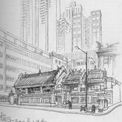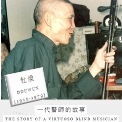 Collections
Collections The Legend of Silk and Wood: A Hong Kong Qin Story
The Legend of Silk and Wood: A Hong Kong Qin Story Art of Silk and Wood
Art of Silk and Wood Qin Making Procedure
Qin Making Procedure Stringing
Stringing
-
Step 9: Stringing
After the lacquered surface has been polished, a tone tester is used to perform an acoustic test of the qin’s sound. If there is buzzing noise, it means the top board of the qin requires further conditioning or another round of cement priming and lacquering. When the lacquering process is complete, the instrument can be stringed and tuned. To mount strings onto the qin, use the tuning tassels (rongkou), which connect with the tuning pegs at the qin bottom, to hook the butterfly bow (yingtou) of the string at the bridge. Tie the other end of each string, around the dragon gum, to the goose feet. Next, turn the pegs to tune. The first group of thicker strings – the first to the fourth – are fastened onto the right goose foot, while the second group of thinner strings – the fifth to the seventh – are tied to the left goose foot. The thicker strings should be mounted first, followed by the thinner ones. New silk strings have to be mounted a few times before they are stabilised.
-
Step 9: Stringing
Tools
- Large tone tester – for testing all seven strings. Place the qin on top to test it.
- Small tone tester – fasten one string onto it, and affix the string onto the bridge and the tail of the qin to perform the acoustic test. Can be used to test a specific string position if needed.
- Tuning pegs and tuning tassels of the qin – if results of the acoustic testing are positive, the tuning pegs and the tuning tassels can be used to mount the strings onto the instrument.





